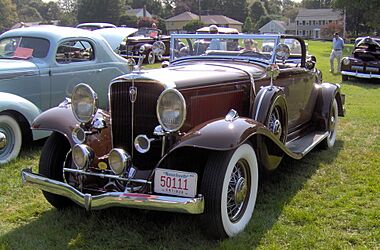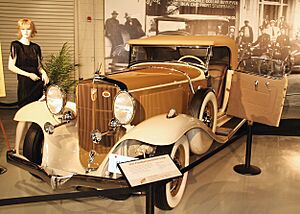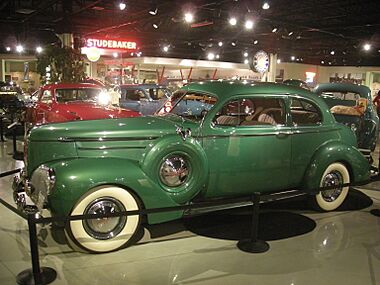Studebaker President facts for kids
Quick facts for kids Studebaker President |
|
|---|---|

1957 Studebaker President
|
|
| Overview | |
| Manufacturer | Studebaker |
| Production | 1926–1942 1955–1958 |
| Assembly | Studebaker Automotive Plant, South Bend, Indiana, United States |
| Body and chassis | |
| Class | Full-size (1926-1942) (1955-58) |
| Layout | FR layout |
| Chronology | |
| Predecessor | Studebaker Big Six (1926) |
The Studebaker President was a very important car made by the Studebaker company. It was built in South Bend, Indiana, USA. This special car was made from 1926 to 1942. Later, the name was used again from 1955 to 1958.
The First Studebaker President (1926-1933)
| First generation | |
|---|---|

1931 Studebaker President four seasons roadster
|
|
| Overview | |
| Production | 1926–1933 |
| Body and chassis | |
| Body style | 2-door roadster 4-door sedan |
| Powertrain | |
| Engine | 354 cu in (5,800 cc) I6 312.5 cu in (5,121 cc) I8 |
Before the President, Studebaker's best car was the Studebaker Big Six. The very first car called "President" came out on July 23, 1926. It had a powerful six-cylinder engine. In 1928, a smoother, smaller eight-cylinder engine was introduced.
Albert Russel Erskine, who was in charge of Studebaker, wanted the President to be the best car in America. These cars cost between $1,985 and $2,485 back then. Cars made from 1928 to 1933 set amazing land speed records. Some of these records lasted for 35 years! The President cars got even better when Studebaker took over Pierce-Arrow in 1928.

In 1931, the engine was made even bigger and stronger. Its crankshaft, a main part of the engine, was designed to get oil better. Many other car engines at the time were not as well-oiled. This helped the engine run more smoothly and powerfully. These improvements made the engine reach 122 horsepower. The car also had modern filters for air, oil, and fuel. It even had a special device to reduce vibrations.
Also in 1931, Studebaker added "Ovaloid" headlights. These were oval-shaped and made it easy to spot a President car. Cars from this time were seen as rivals to expensive brands like Cadillac and Packard. Sadly, Studebaker faced financial trouble in 1933-1934, and Albert Erskine passed away. This brought an end to the era of these big, impressive President cars.
The Second Studebaker President (1934-1940)
| Second generation | |
|---|---|

A 1940 Studebaker President Club Sedan
|
|
| Overview | |
| Production | 1934–1940 |
| Body and chassis | |
| Body style | 2-door roadster 2-door sedan 4-door sedan |
For 1934, Studebaker made its cars more streamlined and offered fewer models. They created a new body style called the "Land Cruiser." This design was also used for the Studebaker Dictator and Studebaker Commander. Land Cruiser models looked very sleek with their special four-piece rear window and covered rear wheels. The new Presidents were smaller than before, but still great cars. They cost about $1,245.
In 1935, some President and Commander cars offered an optional steel sliding roof. This was like the sunroofs we see on cars today. By 1936, all Studebaker cars had a "Planar" suspension system for a smoother ride. They also offered an automatic engine-starting system called "Startix." Cars from 1936 also showed the influence of famous designers like Raymond Loewy. Studebaker also made its "Hill-Holder" device standard on the President. This system stopped the car from rolling backward on hills.
In 1938, Studebaker offered a "Miracle-Shift" transmission. This allowed drivers to shift gears using a control on the dashboard. This feature was stopped in 1939 when the gear shift lever was moved to the steering column.
The Third Studebaker President (1941-1942)
| Third generation | |
|---|---|

A 1941 Studebaker President
|
|
| Overview | |
| Production | 1941–1942 |
| Body and chassis | |
| Body style | 2-door roadster 4-door sedan |
In 1941, the President got a new body style. It was a four-door sedan with rear doors that opened backward. This was different from most cars at the time. This car was also called the Land Cruiser. You could spot it by its hidden running boards and no rear quarter-windows. The Land Cruiser was available in different versions, including the "Skyway" series. The Skyway had nicer seats and a simpler chrome design on the side. This style continued for the short 1942 model year. After that, the President car was stopped.
The Fourth Studebaker President (1955-1958)
| Fourth generation | |
|---|---|

A 1956 Studebaker President 4-Door Sedan
|
|
| Overview | |
| Production | 1955–1958 |
| Body and chassis | |
| Body style | 2-door sedan 4-door sedan 2-door coupe 2-door hardtop 2-door station wagon 4-door station wagon |
| Related | Studebaker Scotsman Studebaker Commander Studebaker Champion Packard Clipper |
| Dimensions | |
| Wheelbase | 120.5 inches |
Studebaker brought back the President name in 1955. It was used for all their top-of-the-line cars. One of the most famous of these later Presidents was the 1955 Studebaker Speedster. The President name was stopped after the 1958 model year. This was because Studebaker started to focus on smaller cars like the Studebaker Lark. The very last Packard cars (from 1957–1958) were actually based on the same design as these Studebaker Presidents.
Motorsports Achievements
The Studebaker President was not just a fancy car; it was fast too! In 1928, it set 118 stock car records. It also finished in third place at the famous 1932 Indianapolis 500 race.
Classic Car Status
The Classic Car Club of America is an important group that decides which cars are "classic cars." They recognize only certain Studebaker President models as "full classics." These include the 8-cylinder FA & FB models made in 1928, and all models produced between 1929 and 1933.
Images for kids






